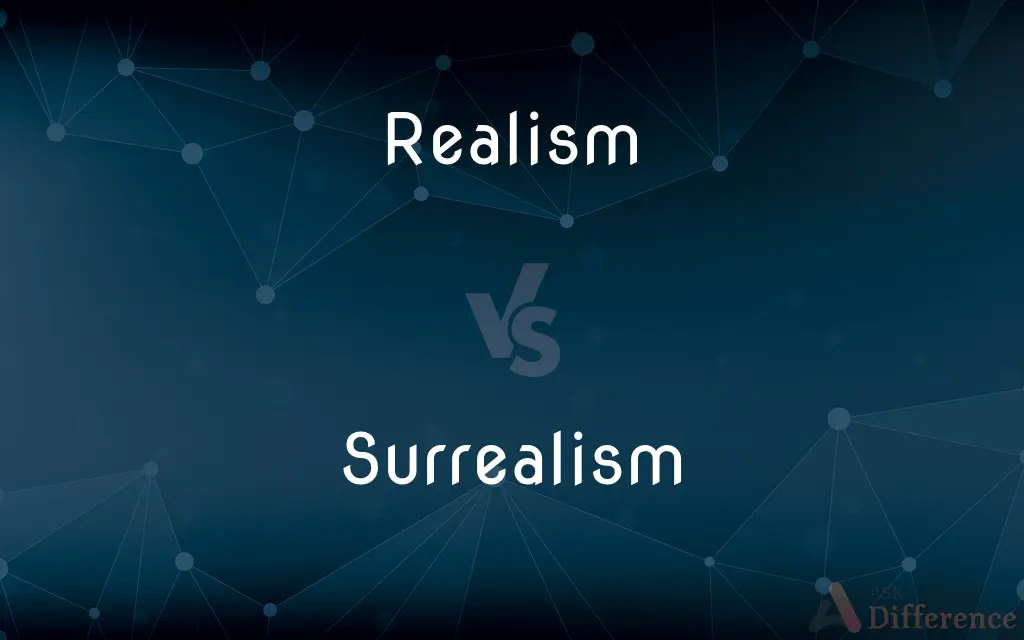Realism vs. Surrealism — What's the Difference?
By Tayyaba Rehman — Updated on October 19, 2023
Realism focuses on depicting everyday life as it is, while Surrealism blends dreams, fantasy, and the subconscious with reality.

Difference Between Realism and Surrealism
Table of Contents
ADVERTISEMENT
Key Differences
Realism and Surrealism are both art movements, but they tackle their subjects from distinct angles. While Realism is concerned with representing life precisely and authentically, Surrealism ventures into the dreamlike and illogical.
Realism emerged in the 19th century and was a response to Romanticism. It prioritized the accurate depiction of daily life, often highlighting the struggles of the everyday person. Conversely, Surrealism, rooted in the 20th century, took inspiration from dreamscapes and the unconscious mind, merging reality with imagination in unexpected ways.
In literature, Realism uses detailed descriptions, ensuring that characters, settings, and events feel genuine. Surrealism, on the other hand, bends and warps reality, leading readers into a world where logic is secondary, and anything can happen.
When observing a Realist painting, one might feel like they're looking at a photograph due to the meticulous attention to detail. A Surrealist painting, however, might leave viewers questioning their sense of reality, as familiar objects take on strange forms and contexts.
Realism and Surrealism, despite their differences, have both significantly influenced the art and literary worlds. While Realism grounds us in the familiar, Surrealism invites us to question and explore the boundaries of reality.
ADVERTISEMENT
Comparison Chart
Origin
19th century
20th century
Main Focus
Accurate depiction of daily life
Blend of dreams, fantasy, and reality
Representative in Literature
Detailed descriptions of characters and settings
Distorted reality and dreamlike narratives
Artistic Presentation
Often photographic in detail
Dreamlike, fantastical, and illogical
Philosophical Basis
Observation of the external world
Exploration of the subconscious and imagination
Compare with Definitions
Realism
An artistic movement focused on representing reality.
The painting's stark Realism captures the hardships of rural life.
Surrealism
A combination of the conscious and unconscious mind.
His poetry, infused with Surrealism, blurred the lines between wakefulness and dreaming.
Realism
Depicting subjects truthfully without artificiality.
Her novel is celebrated for its Realism and authentic portrayal of city life.
Surrealism
Rooted in the exploration of the psyche and dreams.
Surrealism introduced art enthusiasts to the depths of the human subconscious.
Realism
The modern philosophical doctrine, opposed to idealism, that objects exist independently of their being perceived.
Surrealism
A rejection of established conventions in favor of the fantastical.
The sculpture's Surrealism defied traditional expectations, merging the mundane with the magical.
Realism
A literary movement representing everyday life.
19th-century Realism shunned the exaggerated emotions of Romantic literature.
Surrealism
An artistic movement blending dreams with reality.
The painting's Surrealism transported viewers to a dreamlike landscape.
Realism
An inclination toward literal truth and pragmatism.
Surrealism
Emphasizing the illogical and unexpected.
The movie's Surrealism captivated audiences, presenting a world where anything seemed possible.
Realism
The representation in art or literature of objects, actions, or social conditions as they actually are, without idealization or presentation in abstract form.
Surrealism
Surrealism was a cultural movement which developed in Europe in the aftermath of World War I and was largely influenced by Dada. The movement is best known for its visual artworks and writings and the juxtaposition of distant realities to activate the unconscious mind through the imagery.
Realism
The scholastic doctrine, opposed to nominalism, that universals exist independently of their being thought.
Surrealism
A literary and artistic movement of the 1900s that attempts to express the workings of the subconscious and is characterized by fantastic imagery and incongruous juxtaposition of subject matter.
Realism
A concern for fact or reality and rejection of the impractical and visionary.
Surrealism
Literature or art produced in this style.
Realism
An artistic representation of reality as it is.
Surrealism
An artistic movement and an aesthetic philosophy that aims for the liberation of the mind by emphasizing the critical and imaginative powers of the subconscious.
Realism
(sciences) The viewpoint that an external reality exists independent of observation.
Surrealism
A 20th century movement of artists and writers (developing out of Dadaism) who used fantastic images and incongruous juxtapositions in order to represent unconscious thoughts and dreams
Realism
(philosophy) A doctrine that universals are real—they exist and are distinct from the particulars that instantiate them.
Realism
As opposed to nominalism, the doctrine that genera and species are real things or entities, existing independently of our conceptions. According to realism the Universal exists ante rem (Plato), or in re (Aristotle).
Realism
Fidelity to nature or to real life; representation without idealization, and making no appeal to the imagination; adherence to the actual fact.
Realism
The practise of assessing facts and the probabilities of the consequences of actions in an objective manner; avoidance of unrealistic or impractical beliefs or efforts. Contrasted to idealism, self-deception, overoptimism, overimaginativeness, or visionariness.
Realism
The attribute of accepting the facts of life and favoring practicality and literal truth
Realism
(philosophy) the philosophical doctrine that physical object continue to exist when not perceived
Realism
The state of being actual or real;
The reality of his situation slowly dawned on him
Realism
An artistic movement in 19th century France; artists and writers strove for detailed realistic and factual description
Realism
(philosophy) the philosophical doctrine that abstract concepts exist independent of their names
Realism
Grounded in real-life experiences and observations.
The film's Realism resonated with audiences, as it mirrored their own struggles.
Realism
A preference for fact and practicality over fantasy.
His Realism prevented him from believing in the exaggerated tales.
Common Curiosities
Can Realism and Surrealism coexist in a single artwork?
Yes, some artists blend Realistic techniques with Surrealist ideas, creating hybrid works.
What's a key characteristic of Surrealism?
Surrealism often merges dreamlike elements with reality, resulting in unexpected combinations.
Are Realism and Surrealism opposites?
While they're distinct, they aren't exact opposites. Realism focuses on accurate depictions, while Surrealism blends reality with dreams.
Was Surrealism influenced by psychology?
Yes, Surrealism was significantly influenced by the exploration of the subconscious and dream analysis.
When did Realism originate?
Realism emerged in the 19th century.
Is Realism limited to visual arts?
No, Realism is also a significant literary movement representing everyday life.
Why was Realism important in the 19th century?
Realism provided a counterpoint to Romanticism, focusing on real-life struggles and authentic depictions.
Does Surrealism always represent dreams?
Not always. While inspired by dreams, Surrealism also explores the illogical, fantastical, and subconscious aspects of reality.
What does a Surrealist poem look like?
A Surrealist poem might juxtapose unrelated images, explore dream sequences, or delve into the irrational.
What's a notable example of a Surrealist artist?
Salvador Dalí is a renowned Surrealist artist known for his dreamlike paintings.
Were Realism and Surrealism reactions to societal changes?
Yes, both movements responded to societal shifts, with Realism addressing industrialization and Surrealism reflecting post-war sentiments.
Is Surrealism only about strange or bizarre imagery?
No, while it often features unexpected combinations, its core is exploring the subconscious and redefining reality.
Is Realism still a prevalent art form?
Yes, many artists and creators still value Realism for its authenticity and reflection of real-life experiences.
Can a piece of writing be both Realistic and Surrealist?
Yes, some writers blend Realistic narratives with Surrealist elements to create layered stories.
How has Realism influenced modern media?
Modern media, especially film and television, often employ Realism to make stories relatable and authentic to viewers.
Share Your Discovery

Previous Comparison
Specie vs. Species
Next Comparison
Schmuck vs. PutzAuthor Spotlight
Written by
Tayyaba RehmanTayyaba Rehman is a distinguished writer, currently serving as a primary contributor to askdifference.com. As a researcher in semantics and etymology, Tayyaba's passion for the complexity of languages and their distinctions has found a perfect home on the platform. Tayyaba delves into the intricacies of language, distinguishing between commonly confused words and phrases, thereby providing clarity for readers worldwide.














































